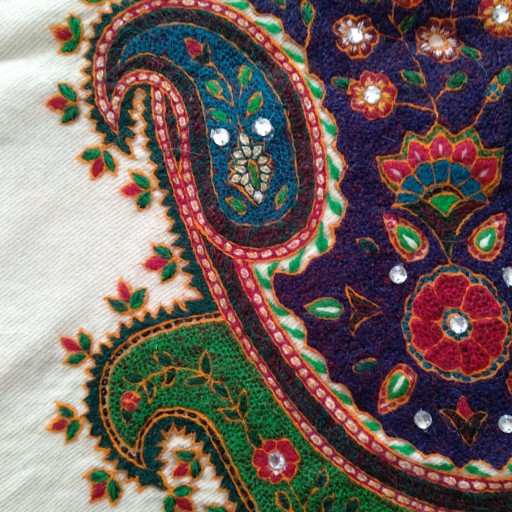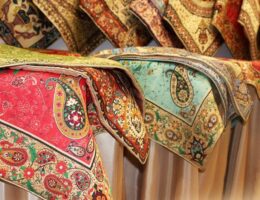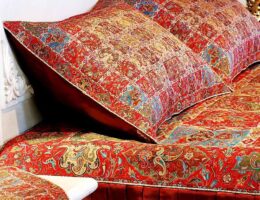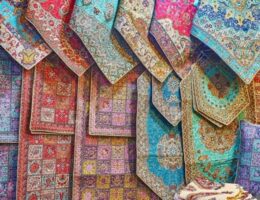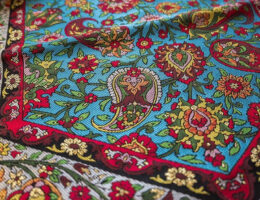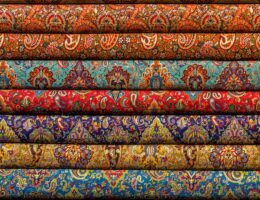IRAN ART EXHIBITION: IF KERMAN IS IN YOUR TRAVEL LIST, DON’T FORGET ABOUT PATEH WEAVING
Pateh-weaving is one of the most beautiful traditional embroideries in Iran which is an art materialized by the hand of the women of Kerman. Pateh-weaving is a special method of needlework which is used to ornament cloth. Since in this type of needlework, almost all the surface of the cloth is embroidered, it is also called sequential embroidery. Pateh-weaving is carried out on a piece of cloth made of think and delicate wool in which authentic and original Iranian patterns life that of paisley, arabesque, and bergamia. The cloth specially used for Pateh-weaving is called cashmere shawl. The cloths worked on in this needlework are used as table cloth, napery, plate undercloth, curtain, and even clothes in addition to such accessories as hand-wrist and the like.
Warnings
The products relevant to Pateh-weaving needlework must be washed with hand and mild detergents and never hung to be dried out when they are still wet since they will be stretched and get out of their natural proportion. They are also sensitive to moisture and thus must be kept in dry places which are relatively cool and exposed the air current.
IRAN ART EXHIBITION: Pate is the kind of Sewing the pattern as hand-stitched on fluffy and woolen fabrics, which are used in woman and girls Kerman. The Pateh is used for sewing Prayer rug, the cover of Quran, curtains, and coaster. Pateh fabric is a thick woolen fabric that is called Ariz.
Usually, women and girls are housewives. With the help of needles and the color cotton stitches, they’re sewing old Iranian patterns such as a tree of life or a Paisley, on the background of thick woolen fabric (Ariz). Threads used the color of sangria, black, light green, dark green, yellow, orange, red, dark blue, lacquer and so on. They mainly use dark thread to make Pateh.
In the past, the use of Pateh-embroidered fabrics by rich people, and has been used as a bundle, curtain, tablecloth, and so on. The oldest “Pateh” is a cloth in the tomb of Shah Nimatullah Wali in Mahan city of Kerman. This Pateh-embroidered made by six ladies in two years and finished in 1285 AH.
• Steps to make Pateh as follows:
To make Pateh, you will first need Ariz dimensions. Then On the tracing paper, they draw their patterns and pierce with the needle. Then carve the patterns on the paper by pouring plaster or charcoal. At the last step, sewed and shaded models by the color threads.
• Take a piece of Kerman with you
One of the best souvenirs of Kerman is Pateh. You can go to the Ganjali Khan bazaar to buy souvenirs from Kerman and buy beautiful Pateh at an affordable price. It is interesting to know that in this bazaar, there is a shop that makes and sells local dolls with a combination of Pateh.
IRAN ART EXHIBITION: Pateh needlework is done in silk and with flourishes of paisley patterns. Popular designs include the cypress tree and the sun, both of which are traditional pre-Islamic Persian symbols.
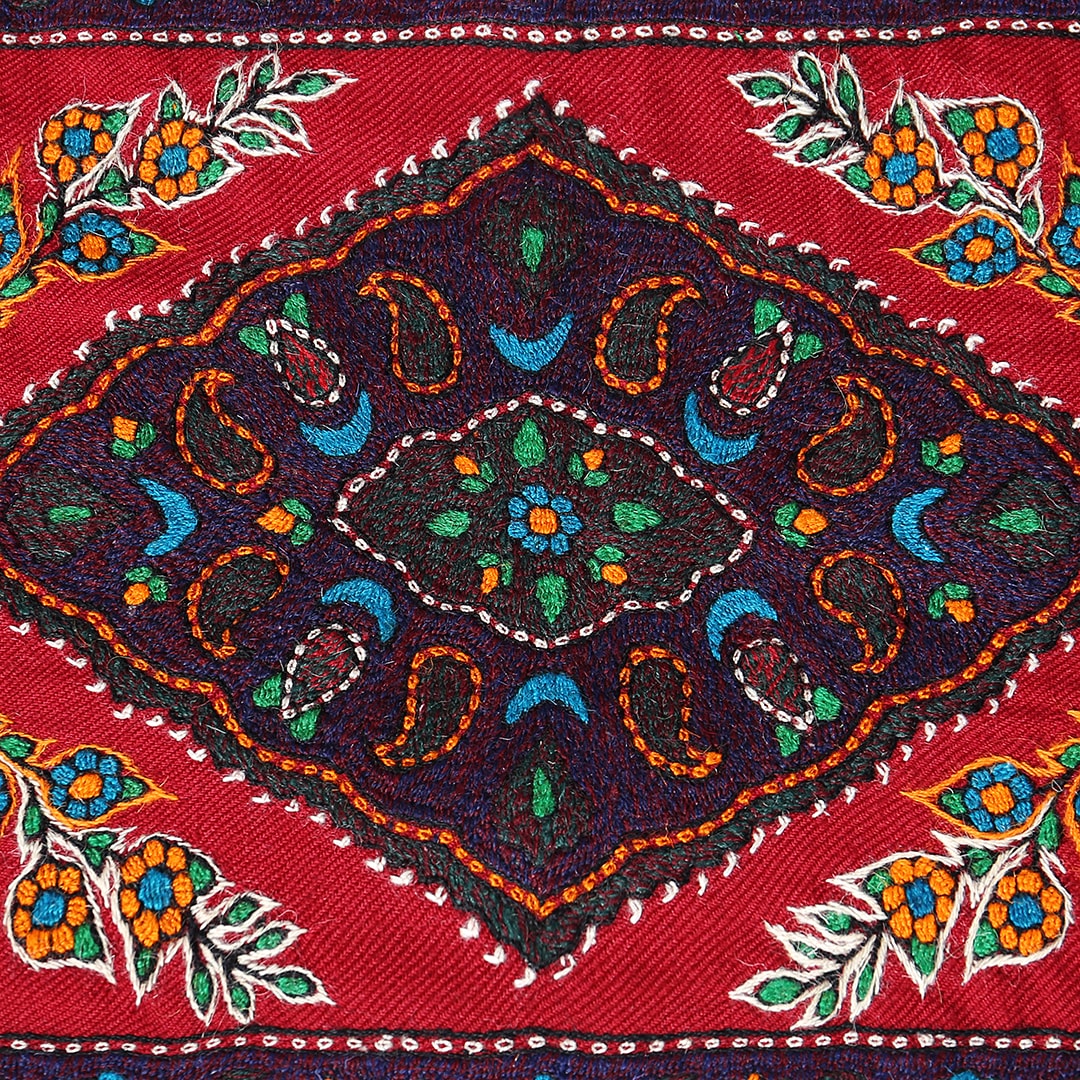
History
Pateh originated and developed in Kerman province. Although its exact origin is unclear, it is assumed that it was influenced by Kerman rug weaving and thus does not predate the latter. The oldest pateh known is dated to the 18th century.
Many valuable pateh pieces are held in art museums, particularly in Tehran. The oldest and most valuable pateh known is kept in the Astaneh Museum in Mahan, Kerman and dates to 1294 AH (1877 CE). It was created over the course of three years by twelve women. Governor Shahab al-Mulk ordered its creation so that it could be dedicated to the shrine of Shah Nimatullah Wali, a dervish and poet who was born in Kerman.
Structure
Pateh mainly consists of two parts: “shawl” (ariz) and thread. The ariz is a thick cloth, usually wool, and the thread that is worked into it is colored wool. Threads are dyed naturally, usually with henna, pomegranate, madder or the walnut’s green husk.
The patterns which are used in Pateh are normally divided into two main groups: “The Paisley” and “The Tree”. One of the most popular patterns consists of four Paisleys on the corners and a toranj at the center. Sometimes flower bouquets are being used instead of paisley. Another common design is called mihrab in which an arch is being made on the top of the pateh. However, one of the essential parts in a design for pateh is margin which is typically filled with flowers or different kinds of paisley.
IRAN ART EXHIBITION: Pateh Douzi, which is the art of sewing a kind of embroidery in which all over of the textile is covered by colorful stitches, is one of the most significant handicrafts and souvenirs of Kerman province.
Due to the vulnerability of textiles no Pateh product has survived from ancient times, and very little is known about its history. However, according to travel documentaries and texts that belong to the Safavid era, cultural heritage experts are almost certain that Pateh was quite popular in Kerman during that time.
The makers of Pateh are most commonly young girls and women of Kerman who sew the patterns from their imagination on wide and thick fabrics called Ariz or Shawl.
One of the oldest surviving pieces of Pateh, which belongs to ca. 1869, was used as the cover of the tombstone of Shah Nimatullah Wali who was a Persian Sufi master and poet of the 14th and 15th centuries.
